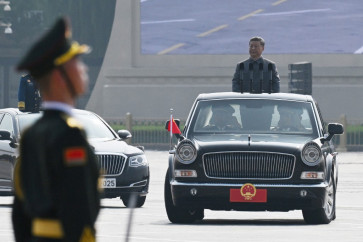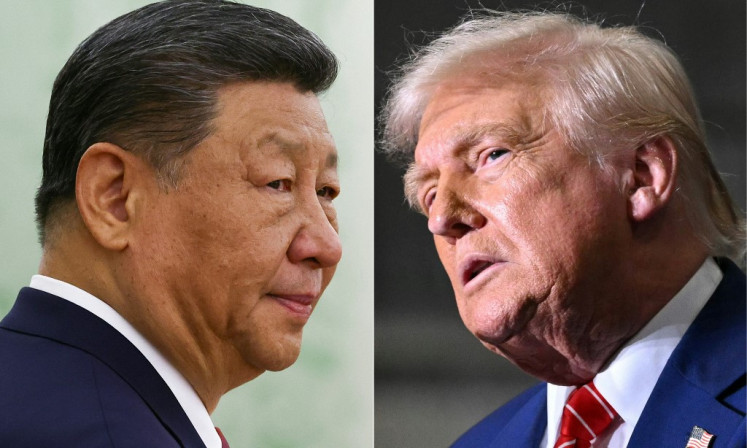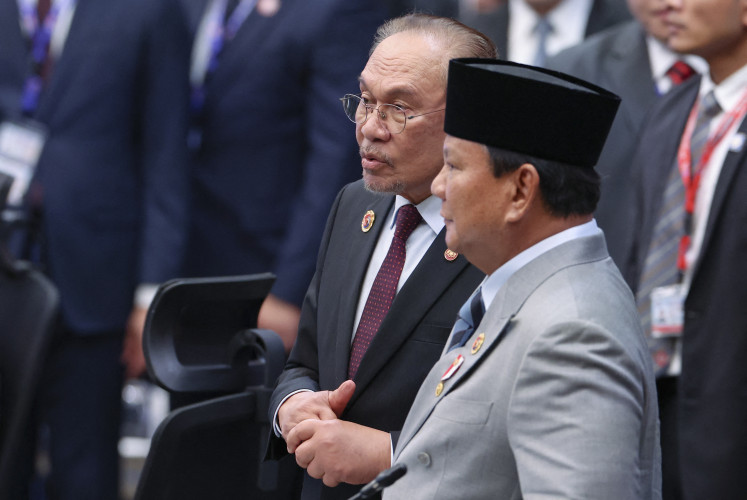Popular Reads
Top Results
Can't find what you're looking for?
View all search resultsPopular Reads
Top Results
Can't find what you're looking for?
View all search resultsMax Baihaqi: Alternative 'keroncong' & musicalized poetry
(JP/Ganug Nugroho Adi)In mid-September, Max Baihaqi and his group, Plasu Minimalis Orchestra (OPM), livened up Solo Keroncong Festival 2013 by presenting alternative keroncong, a non-standard offshoot of the Portuguese-tinged pop music genre
Change text size
Gift Premium Articles
to Anyone
(JP/Ganug Nugroho Adi)
In mid-September, Max Baihaqi and his group, Plasu Minimalis Orchestra (OPM), livened up Solo Keroncong Festival 2013 by presenting alternative keroncong, a non-standard offshoot of the Portuguese-tinged pop music genre. Max has changed genuine keroncong with its slow and refined rhythm to free, humorous and dynamic music.
Max has arranged most of the songs brought by OPM so that the keroncong instruments like the ukulele, cello, violin, contrabass, guitar, flute and drum become compatible with keroncong music played in the beats of langgam (Javanese keroncong), jazz, blues, hip-hop, pop, Malay, dangdut (Hindi-tinged pop), reggae and rock.
As a result, the keroncong music they offer will prompt spectators to shake their bodies, which is an
uncommon sight in a conventional keroncong music concert.
'In the genuine version, OPM will surely be overwhelmed by the orchestra of the Indonesian Keroncong Music Artists Association (HAMKRI) or Pesona Jiwa Orchestra under Koko Thole. We've got to explore and appear with a different kind of keroncong so as to be noticed,' said Max.
In his view, traditional arts including keroncong will never fade away by always representing their times. Citing an example, he mentioned keroncong maestro (the late) Gesang, who created 'Bengawan Solo' (Solo River) in 1940 actually by defying conventional keroncong standards.
Through his creativity, noted Max, Gesang had infused the rhythm of langgam into his song. Gesang included the traditional pentatonic tones of gamelan in keroncong music. Not only Gesang, the same creative skills have also been applied by several distinguished musicians and composers like Anjar Any, (the late) puppet master Ki Narto Sabdo, and senior keroncong vocalist Wadjinah.
'What I've been doing is nothing new, it's only an adaptation to the period I'm now living in. So my keroncong music follows the current rhythms of hip-hop, blues, jazz, rock and also dangdut,' revealed the husband of Prico Diana Dewi.
In spite of keroncong innovations, according to Max, genuine keroncong music remains great and will survive all kinds of exploration. The presence of alternative keroncong just serves as one way of preserving keroncong music.
'Never be allergic to the exploration of keroncong. It's not an artifact that must be protected from tinkering. Keroncong should live on in accordance with prevailing times, among others through creations. Dare to be different in order to be heeded. Avoid imitation,' said the man once touring Southeast Asia to stage alternative keroncong.
As a proficient musical arranger, the man born Makhfulan Baihaqi has been involved in various art communities in Solo, Central Java, encompassing not only music but also dance, theater and wayang (shadow puppet play).
He has handled the musical illustrations of such big dance concerts as those under noted choreographers Elly Luthan, Mugiono Kasido and Eko Supriyanto, besides Solo theater groups' musical accompaniments.
'I'm a self-taught musician without formal training. As a junior high school student, I learned a lot of music from street singers,' said Max, who gives vocal lessons at Charmista music school.
Born in Magelang, Central Java, on May 19, 1968, Max was brought up in a religious family. His father was an Islamic teacher demanding his children to focus on religion rather than arts.
Max got acquainted with music through a toy hawker in his village. A bamboo flute was among the toys, which attracted Max although he was unable yet to play it and had to spend his week-long pocket money to buy it. 'As I was herding goats, I tried to play some melodies I'd heard over the radio with nobody teaching me,' he recalled.
Finishing primary school, Max attended junior high school located 10 kilometers from his home. Staying at a lodging house, he learned to play the guitar from several truck drivers near the house and later made some money as a street singer.
He became a street musician until his graduation from senior high school. His father sent him to the Teacher's Training School, Sebelas Maret State University (UNS), Solo, in the belief that teaching would have better prospects than playing music.
The strong sense of art pervading Solo at the time was just intensifying Max's artistic activity, particularly after he met with a number of artists like Suprapto Suryodharmo (choreographer), Blacius Subono, Dedek Wahyudi (gamelan musicians), Hanindyawan (dramatist), even Gesang, and Ki Manteb Soedarsono (puppet master).
Therefore, Max began to learn traditional music, theater and dance from the artists of the Indonesian Arts Institute (ISI), Solo. 'When my musical score for Peron Theater [UNS] won the Central Java theater festival, I was asked to handle drama and dance music,' said the youngest of six siblings.
Apart from alternative keroncong, Max is also known for initiating the musical rendering of poetry. Through his Sound of Poems group, he has turned poetry into music.
'The concept of Sound of Poems is not to sing poems, but rather, to translate poems into music. We only make instrumentals on occasions because not all verses are pleasant for music,' he indicated.
Like ensemble music, the works of Sound of Poems are solemn, ornamental and opera typed. Wishing to expose the hidden side of poetry, Sound of Poems has released three albums: Hymne Rakyat (People's Hymn), Genesis, and Arc.
'We want to be a bridge between poetry lovers and music buffs so that they will enjoy both arts,' added Max, who has often staged the musical verses of Indonesian eminent poets.










